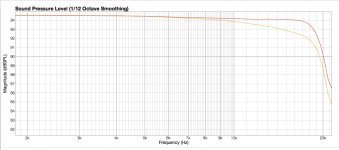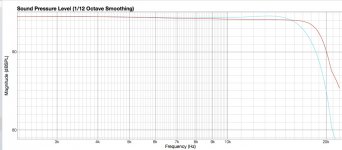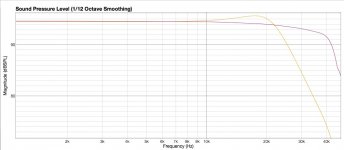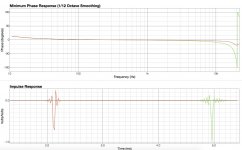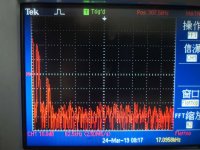Filter from the Board was replaced with styroflex a while ago. Now it is replaced by my “brutal” filter approach.I do have a few questions here.
Here is an except from the dam manual:
“The dam1121 upsamples everything to the final 2.8/3.1 Mhz DAC sample rate in two steps, there are three different filters in the dam1121”
I know that NOS filters were made, also by the so called “filter Meister Paul”. The latest was the NewNOS. As I understood from reading the dam1021 filter thread this inserts some zeros but it is still up sampling. If I’m wrong I happy take “no you’re wrong” for an answer.
Till then I’m not sure if the Dam can be considered as a true NOS DAC.
Second question. If you want to filter the high frequency’s with an extra filter after the DAM board, did you remove the onboard C? If not you're filtering twice, on purpose. I do have no problems with that but one seems useless then no?
Sorry if I’m repeating myself of get on someone’s nerves with this RC or “output” C Filter thing.
Well it measures very NOS. beautiful steps on the scope, hf loss like predicted.
Too much ripple on top of those steps?
As for comparisons to other NOS dacs, perhaps i am wrong. It is hard to make a meaningful comparison as there are too many external variables, per example the presence of an i/v stage.
Filter slightly modified
Hi
Just a short update:
I changed the inductors to those: Fastron 09P-822J-50 8,2mH
They seem to have a different resonance behaviour despite the same inductance as the old ones.
And I changed the second capacity from 13600pF to 11500pF (6800pF and 4700pF in parallel)
The filter cutoff is now at a higher frequency and the resonant peak is flatter, it measures better than the original filter in the frequency domain, but the suppression of mirrors is worse.
I listen to it right now and I really like it, not sure it sounds better than the old one, but not worse for sure.
In the meantime I disconnected the filter to recalibrate my ears with the c128 filter from Paul, but coming back to NOS with analogue filtering sounds more natural to me, so I guess it will stay.
Unfortunately no one else tried this until now, I would love to hear some opinions....
First thumbnail is the new filter vs nos 44.1k
Second is the old filter vs the new one
Third is new filter vs nos at 96k. You look at the real filter response (With resonant peak) up to around 40k. The energy of the mirrors in the critical 40k area is massively reduced, they should not bother amps or speakers very much any more, I guess....
Hi
Just a short update:
I changed the inductors to those: Fastron 09P-822J-50 8,2mH
They seem to have a different resonance behaviour despite the same inductance as the old ones.
And I changed the second capacity from 13600pF to 11500pF (6800pF and 4700pF in parallel)
The filter cutoff is now at a higher frequency and the resonant peak is flatter, it measures better than the original filter in the frequency domain, but the suppression of mirrors is worse.
I listen to it right now and I really like it, not sure it sounds better than the old one, but not worse for sure.
In the meantime I disconnected the filter to recalibrate my ears with the c128 filter from Paul, but coming back to NOS with analogue filtering sounds more natural to me, so I guess it will stay.
Unfortunately no one else tried this until now, I would love to hear some opinions....
First thumbnail is the new filter vs nos 44.1k
Second is the old filter vs the new one
Third is new filter vs nos at 96k. You look at the real filter response (With resonant peak) up to around 40k. The energy of the mirrors in the critical 40k area is massively reduced, they should not bother amps or speakers very much any more, I guess....
Attachments
I listen to it right now and I really like it, not sure it sounds better than the old one, but not worse for sure.
Try some of the violin pieces. You should hear the difference between different cutoffs, even after 20Khz. Personally, I think the cutoff at 18Khz is a bit early. I prefer a steep filter just right after 20Khz.
Poting
The high frequency attenuation of the NOS output is not true high frequency attenuation, but because the clock of the DAC is inconsistent with the clock of the instrument's ADC. After the ADC output is internally filtered and processed, the high frequency tested is attenuated. If the ADC and DAC use the same LRCK, there will be no attenuation problems.
On the other hand, even if the NOS does not add any filtering, the human ear hears that the NOS still feels that the high frequency attenuation is due to the interference of the image frequency, and the sound burr but the high frequency is not clear.
On the other hand, even if the NOS does not add any filtering, the human ear hears that the NOS still feels that the high frequency attenuation is due to the interference of the image frequency, and the sound burr but the high frequency is not clear.
I think NOS frequenccy response is due to the sample and hold nature of a dac. It is really inherent to that way of conversion. A digitally produced sine sweep is precisely measuring as expected at a NOS dam1021. So correcting that in the analogue domain is necessary, correct and easy as shown above.
Still using that mode and it sounds beautiful to my old ears.
Still using that mode and it sounds beautiful to my old ears.
The high frequency attenuation of the NOS output is not true high frequency attenuation, but because the clock of the DAC is inconsistent with the clock of the instrument's ADC. After the ADC output is internally filtered and processed, the high frequency tested is attenuated. If the ADC and DAC use the same LRCK, there will be no attenuation problems.
On the other hand, even if the NOS does not add any filtering, the human ear hears that the NOS still feels that the high frequency attenuation is due to the interference of the image frequency, and the sound burr but the high frequency is not clear.
Setting aside the complexities of Sigma-Delta-Modulator conversion.
The famous NOS high-frequency roll-off curve also occurs via Oversampled operation. It is an function of the hold period of sample-and-hold ('Zero Order Hold') type D/A units. Which is to say, nearly all audio D/A units. The shorter is the D/A unit hold period, the higher in frequency will be the roll-off curve. Inversely, the longer is the hold period, the lower in frequency will be the roll-off curve. The D/A hold period itself is determined by the effective sample rate (meaning, the final sample rate, including any oversampling) sent to it. The higher the rate, the shorter the hold period. Therefore, NOS operation will exhibit the lowest frequency roll-off curve for a given native sample rate, simply because it exhibits the longest D/A unit hold period.
Analog EQ of the roll-off curve can be performed on the NOS DAC's analog output signal. As for Oversampling DACs, the digital interpolation/filter typically includes an built-in digital EQ function to correct for the reduced, but still present, roll-off effect.
Last edited:
It seems that the Nyquist sampling theorem cannot be established? For example, the PCM1704 has a bandwidth of at least 2MHz (setting time is 200ns), and there is almost no attenuation at 22.05kHz. But if you test the unfiltered NOS PCM1704, the 20kHz attenuation will be greater than 3dB。So what do you think is the oversampling of the digital filter to compensate for the high frequencies? The frequency response curve of the digital filter in the spec is problematic?
It seems that the Nyquist sampling theorem cannot be established? For example, the PCM1704 has a bandwidth of at least 2MHz (setting time is 200ns), and there is almost no attenuation at 22.05kHz.
As I'd mentioned before, the roll-off curve is a function of the D/A unit's hold-period. Where the hold-period is a function of the final sample rate actually sent to the D/A quantizer unit. The hold-period is not a direct function of the setting-time.
The 200ns. settling-time specifies the period in which the DAC's analog output is inaccurate after a quantizer conversion-cycle is initiated. In other words, the output is not accurate until AFTER 200ns. So, even should the DAC's associated control circuitry support an 200ns. conversion rate, the analog output would be, by definition, inaccurate 100% of the time. Instead, refer to the maximum conversion rate specification given in the datat sheet, which I believe is 768kHz for the PCM1704.
But if you test the unfiltered NOS PCM1704, the 20kHz attenuation will be greater than 3dB。So what do you think is the oversampling of the digital filter to compensate for the high frequencies? The frequency response curve of the digital filter in the spec is problematic?
Yes, at a 44.1kHz sample rate, the uncorrected response is -3.16dB @ 20kHz. One way to correct for the roll-off is to equalize it. That can be done either the digital, or analog domains. In the digital domain, audio oversampling digital interpolator/filter units typically also provide the necessary EQ. Alternatively, if utilizing an high oversampling ratio, the roll-off can also be corrected(relocated) without resort to EQ by moving it high enough in frequency that it's effect is negligible within the audio band. For example, with CD sample rate audio, 16x oversampling roughly appears to be the minimum ratio for that purpose.
Last edited:
Bandwidth and sample rate are two incompletely related parameters, such as ADC LTC2378-20, which has a bandwidth of 34MHz, but the sampling rate is up to 1Msps. PCM1704 bandwidth is calculated based on setup time, 1/2.2Tset, but the highest sampling rate is 768k. Bandwidth is just an analog parameter.
In addition, oversampling only attenuates the out-of-band spectrum and does not compensate for high frequencies. NOS has no high frequency attenuation, just a test environment problem. If the NOS's 20 kHz is to be properly tested, the ADC sample rate bandwidth and sample rate must be high enough to then make a 22 kHz steep drop in the digital domain. The AP2700 series has insufficient bandwidth and sampling rate.
In addition, oversampling only attenuates the out-of-band spectrum and does not compensate for high frequencies. NOS has no high frequency attenuation, just a test environment problem. If the NOS's 20 kHz is to be properly tested, the ADC sample rate bandwidth and sample rate must be high enough to then make a 22 kHz steep drop in the digital domain. The AP2700 series has insufficient bandwidth and sampling rate.
The high frequency response roll-off is NOT a function of analog circuit bandwidth, nor is it a function of the ADC's sample rate. It's an effect inherent with Zero-Order-Hold(ZOH) type DAC operation and a function of the data conversion cycle hold period. Which itself, is determined by the DAC's conversion/sample rate. Not by analog circuit bandwidth.Bandwidth and sample rate are two incompletely related parameters, such as ADC LTC2378-20, which has a bandwidth of 34MHz, but the sampling rate is up to 1Msps. PCM1704 bandwidth is calculated based on setup time, 1/2.2Tset, but the highest sampling rate is 768k. Bandwidth is just an analog parameter.
That is an incomplete analysis. Yes, oversampling serves to attenuate(spectrally translocate, actually) the ultrasonic image bands. However, when oversampling is used in conjunction with ZOH type DACs, such as the PCM1704, it then also moves the hold period based frequency response roll-off of the DAC higher up in frequency, whiich then makes the upper audio band response more flat as a consequence. So, it does compensate.In addition, oversampling only attenuates the out-of-band spectrum and does not compensate for high frequencies.
No. NOS @ 44.1kHz utilized in conjunction with ZOH type DAC's exhibits an -3.16dB@20kHz roll-off. What's more, such an roll-off exists for all sample rates. Only it's frequency location changes, moving higher as the sample rate is increased. It has absolutely nothing to do with the test environment.NOS has no high frequency attenuation, just a test environment problem.
The audio band high frequency response roll-off we've been discussing has nothing to do with the ADC. Again, it's an direct consequence of the SINC-function shaped frequency response mask inherent to ZOH type DAC operation, which is determined by the hold period.If the NOS's 20 kHz is to be properly tested, the ADC sample rate bandwidth and sample rate must be high enough to then make a 22 kHz steep drop in the digital domain. The AP2700 series has insufficient bandwidth and sampling rate.
Last edited:
It seems that you don't know the principle of under sampling, so you think the bandwidth depends on the sampling rate. Bandwidth is an analog parameter, which is determined by the setup time. If the sampling rate of NOS is 768k, you can see that there is almost no attenuation at 20kHz. So PCM1704 will not attenuate 3 dB at 20 kHz with 44.1kHz sample rate. You said that the rise and fall edge of DAC output is indeed a factor affecting bandwidth, but the reduction of sampling rate does not mean that the signal within 1/2fs is attenuated. These theories are derived from the Nyquist Sampling Theorem, and it is useless to say more.
The theorie is easily approved with the dam1021 in NOS "filter" mode. A digitally generated sine sweep, measures exactly like it should (look at my measurements), signal is taken straight from the resistor ladder...
So, do you know for an absolute fact that digital EQ is not still being applied in that mode?
It seems that you don't know the principle of under sampling, so you think the bandwidth depends on the sampling rate. Bandwidth is an analog parameter, which is determined by the setup time.
Bandwidth is a subject which ONLY you've been raising. As far as not knowing the principles at discussion, perhaps, you should first look in to the nearest mirror to find the most guilty person.
If the sampling rate of NOS is 768k, you can see that there is almost no attenuation at 20kHz. So PCM1704 will not attenuate 3 dB at 20 kHz with 44.1kHz sample rate.
Oh, I see your logic here. If there is no 20kHz attenuation at an 768k sample rate, then that necessarily means there isn't any attenuation at an 44.1k sample rate. Yes, flawlessly logical!
You said that the rise and fall edge of DAC output is indeed a factor affecting bandwidth, but the reduction of sampling rate does not mean that the signal within 1/2fs is attenuated. These theories are derived from the Nyquist Sampling Theorem, and it is useless to say more.
Now you're just freely attributing statements to me which are demonstrably false. Like the topic of bandwidth which you soley keep raising, I've said absolutely nothing about rise or fall edges. Your assertion that I have said anything about either is so completely mystifying that I must wonder whether you are thinking of some other person, in some other thread.
Yes, unfortunately, it is now quite apparent that it's useless to say more. Let's just leave it at that.
Last edited:
The theorie is easily approved with the dam1021 in NOS "filter" mode. A digitally generated sine sweep, measures exactly like it should (look at my measurements), signal is taken straight from the resistor ladder...
Hop.Sing,
Upon rereading, it occurs to me that I may have misunderstood your comment. I haven't seen the dam1021 NOS measurements to which you refer. Did you intend to affirm the existance of the -3dB NOS roll-off?
Hop.Sing,
Upon rereading, it occurs to me that I may have misunderstood your comment. I haven't seen the dam1021 NOS measurements to which you refer. Did you intend to affirm the existance of the -3dB NOS roll-off?
Yes, that was my intention
I opened the thread with an idea to correct the frequency response and provide some filtering in the analogue domain with this particular dac in NOS mode...
Last edited:
The high frequency response roll-off is NOT a function of analog circuit bandwidth, nor is it a function of the ADC's sample rate. It's an effect inherent with Zero-Order-Hold(ZOH) type DAC operation and a function of the data conversion cycle hold period. Which itself, is determined by the DAC's conversion/sample rate. Not by analog circuit bandwidth.
That is an incomplete analysis. Yes, oversampling serves to attenuate(spectrally translocate, actually) the ultrasonic image bands. However, when oversampling is used in conjunction with ZOH type DACs, such as the PCM1704, it then also moves the hold period based frequency response roll-off of the DAC higher up in frequency, whiich then makes the upper audio band response more flat as a consequence. So, it does compensate.
No. NOS @ 44.1kHz utilized in conjunction with ZOH type DAC's exhibits an -3.16dB@20kHz roll-off. What's more, such an roll-off exists for all sample rates. Only it's frequency location changes, moving higher as the sample rate is increased. It has absolutely nothing to do with the test environment.
The audio band high frequency response roll-off we've been discussing has nothing to do with the ADC. Again, it's an direct consequence of the SINC-function shaped frequency response mask inherent to ZOH type DAC operation, which is determined by the hold period.
You are right. I always thought that the ideal DAC is the R-2R DAC, which perfectly restores the original signal and only adds the image spectrum. However, the result of the function calculation proves that its ZOH characteristic is indeed a function of (sinx)/x (X=f*pi/44.1k). Later I tested the FFT transform of the NOS AD1851 with a 200M digital oscilloscope. Even if the sampling rate is set to 2.5 MHz, 18 kHz also has about 2.5 dB attenuation. Calculated by switching the AD1851 to work at 44.1k and 192k sample rates. This attenuation is similar to a linear interpolation filter. Thank you very much for making me realize this mistake.
BR,
Mark
Attachments
Last edited:
- Status
- This old topic is closed. If you want to reopen this topic, contact a moderator using the "Report Post" button.
- Home
- Source & Line
- Digital Line Level
- DAM1021 NOS with a 3 Pole passive filter
